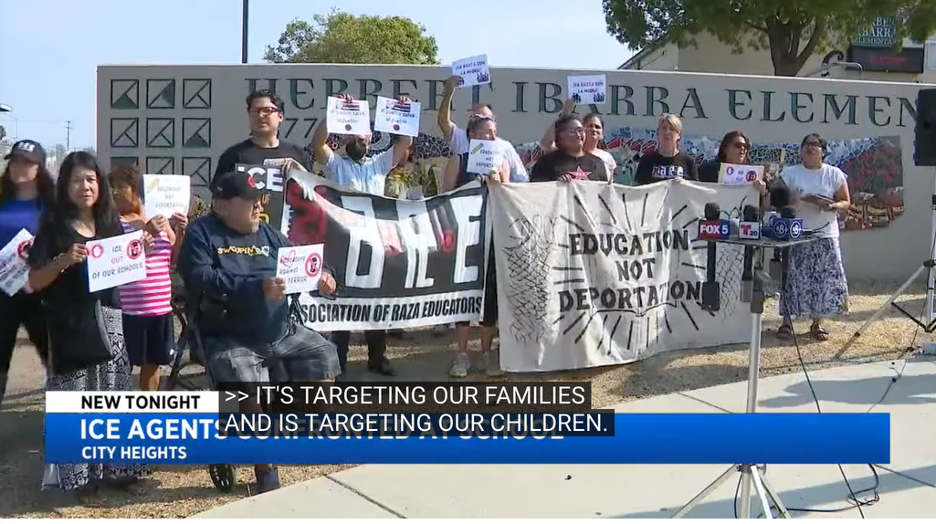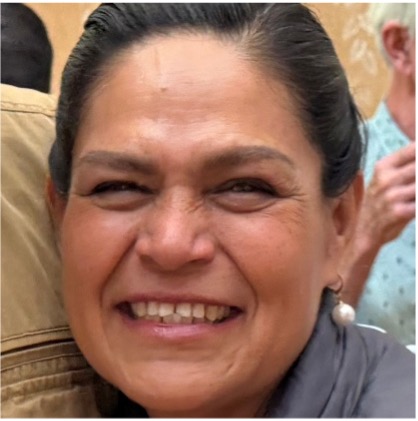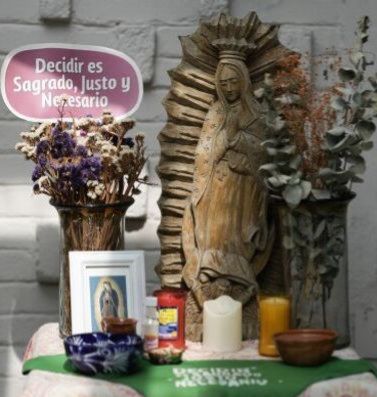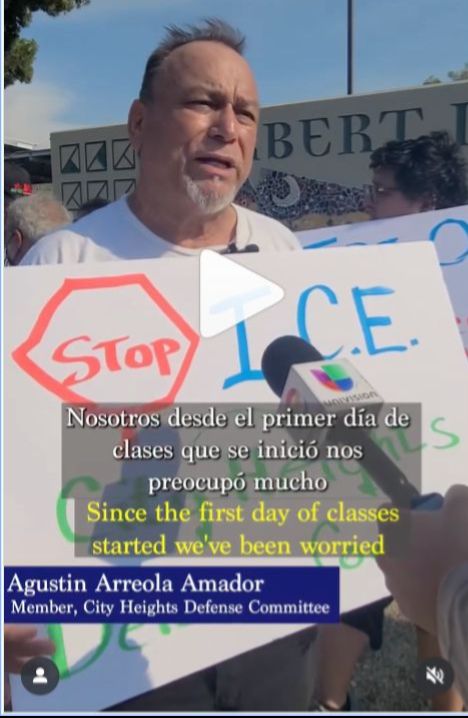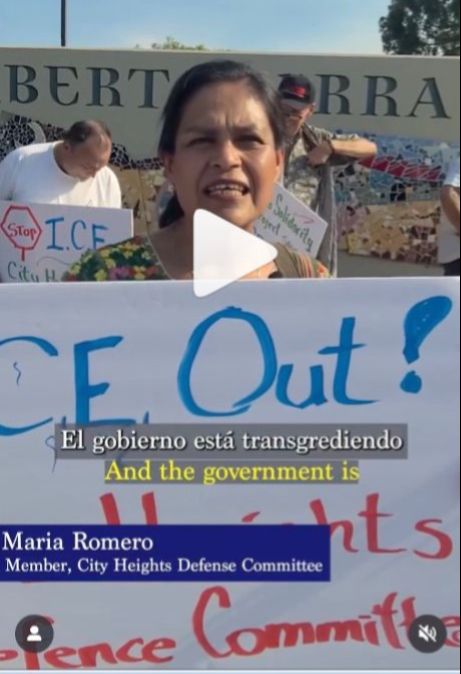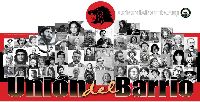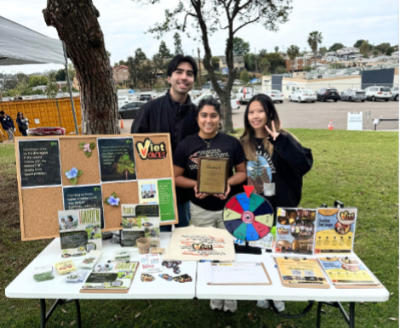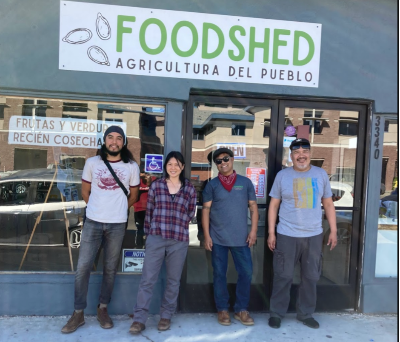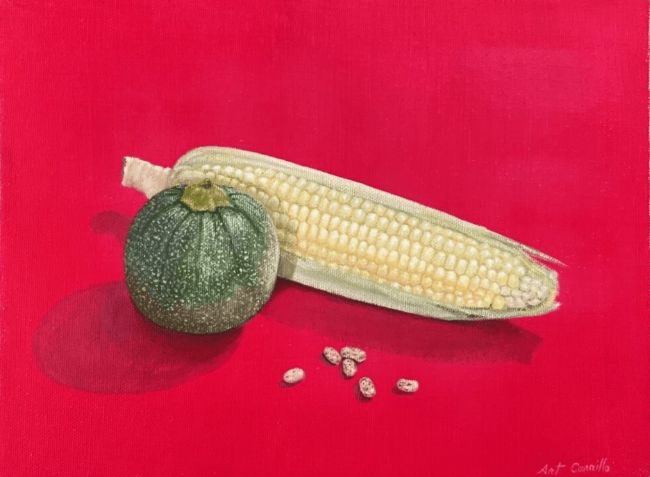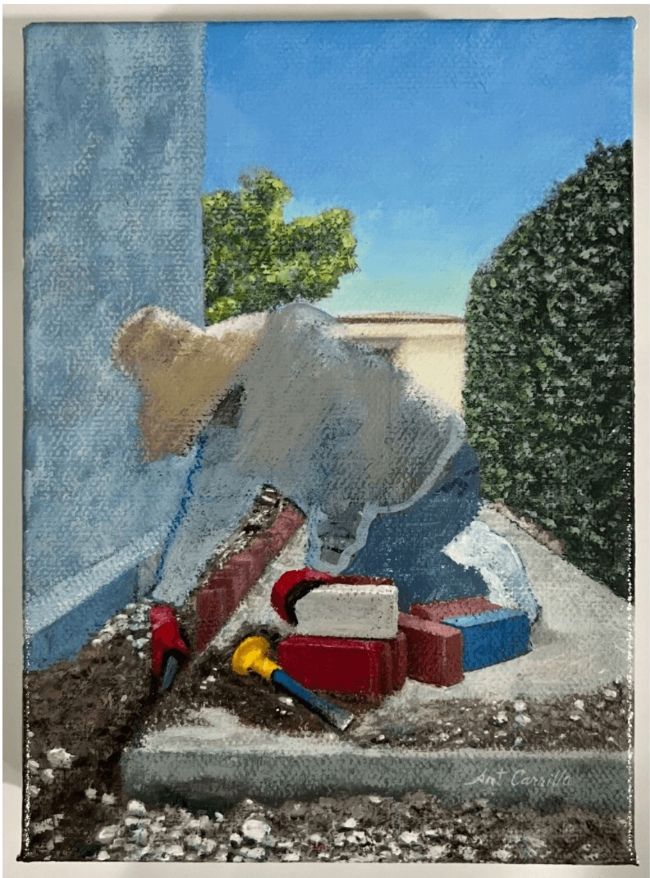|
|
The weekly newsletter of the Mexico Solidarity Project |
|
Every issue archived online at mexicosolidarityproject.org/archives/ |
|
November 05, 2025 |
|
|
|
Meizhu Lui, for the editorial team |
|
Neighbors Battling Hate with Love |
|
|
Citizen activists responds to suspected ICE agents at City Heights school. ABC 10 News |
|
Ever since Trump became president again, tensions have been rising across the US, especially in migrant communities. Trump promised that as president he would cleanse what he views as the US “white" national fabric by removing its brown, black and yellow stains.
His presidency has been worse than even the gloomiest of us imagined. ICE has ballooned grotesquely, rushing to hire recruits without rigorous background checks or proper training. Federal troops have invaded US cities, their hunt for migrants reminiscent of the hunt for runaway slaves two centuries ago.
Immigrant neighborhoods like City Heights in San Diego are potentially major targets of the Trump assault. And it’s here, in their neighborhood, that ordinary people are mobilizing. These are not politicians or well-known leaders, and they are not waiting for someone else to save them, nor are they saying they don’t know what to do. Inventing as they go, they reach out to every organization, every small business, every church, every school and every individual determined to defend their neighbors.
This guerrilla army differs from the armies of past people’s wars. No guns, no violence. They use what comes to hand, like pots and pans to warn people that ICE is around, signs in business windows saying “employees only,” bags of food for those who don’t dare leave home and rock bands with anti-ICE lyrics. When a resident takes a small step, their neighbors applaud and encourage them to take another step. Commitment and courage grow.
What does resistance look like in City Heights? It looks like a festival of diversity, creativity, acceptance and love. Maria Romero tells us that after ICE is gone, City Heights will surely be a more wonderful place to live than ever before. |
|
|
We are the World: a Neighborhood Unites |
|
In her 30s, María Romero never expected to leave her native Mexico, but because of her political activities, she had to flee. Settling in San Diego near the border, she still regularly visits her family in Tijuana. She's passionate about assisting immigrants and adult learners and participates in community struggles organized through Activist San Diego. Currently, as a dedicated organizer in the City Heights Defense Committee, she works to educate and empower City Heights residents to keep ICE out of their community and to end unjust deportations and family separations. |
|
|
You’re a migrant yourself. Why did you come to the US?
I’m from Mexicali, Baja California. It’s a border city with the US on the other side of the fence. When I was young, farmers went back and forth with no problem. Not like today! |
|
In 2000, I graduated from law school, and because I wanted to work on behalf of the common people, I got a job in the local Mexican Human Rights office. But then a difficult case came to me. A young girl had been raped. Abortion was illegal, except in the case of rape — but she was denied an abortion! When I fought for her, I began getting anonymous threats from church fanatics, saying I should be dead because I was pro-choice. A Catholic priest even made threatening flyers with my name on them, calling me a lesbian criminal! It got so bad we had to leave; my husband and I moved to Oregon. |
|
|
More recently, Catholics for the Right to Decide have organized to fight for reproductive rights: 2023. AP Photo/Eduardo Verdugo |
|
But in the US, I couldn’t work as a lawyer. I cleaned houses, did elder care, waitressed — anything! At first, I had a visa, but it ran out, and I became undocumented.
My husband was abusive, and we separated in 2009, when my son was three. In 2010 I was trying to get asylum on the basis of the threats in Mexico, but a Catholic Charities counselor recommended I file instead as a victim of domestic violence. That worked, and I got a permit to work. In 2015, I finally got my status adjusted to that of resident. I could see my family again after ten years of being unable to cross the border to home!
When Trump sent ICE into San Diego, you and several of your activist friends decided to take action. Why did you pick City Heights for defense work?
We live in City Heights! This area isn’t only rich or only poor — it has some big houses but also apartments with workers. In my building, it’s mostly Blacks, but also whites and Mexicans. A building on one side of mine houses Chinese, Laotian and Vietnamese, and on my other side, Turks, Egyptians, Africans and Haitians — within a mile, you can find the whole world! |
|
A center nearby teaches English as a Second Language and provides services for refugees — one reason City Heights is San Diego’s most diverse neighborhood. |
|
|
City Heights, San Diego |
|
Home to so many immigrants, it’s where ICE will naturally show up looking for people to deport. We want to organize our community to keep ICE out.
How did you start the City Heights Defense Committee (CHDC)?
A few of us who worked in Activist San Diego approached several organization leaders and brought them together. The Employee Rights Center, or ERC, works in San Diego and is known across the country for its combination of service, advocacy and organizing of immigrants. Viet Voices enables the usually ignored Vietnamese community to vote and to make their concerns heard. Foodshed, a farm cooperative that grows and distributes fresh foods to improve health, and San Diego Veterans for Peace, an advocacy group for war victims, which many migrants are, all joined. I know I’m forgetting others right now; my apologies.
They all had different areas of work, but the threat of ICE inspired them to come together. Pastors also joined us, and the Church of the Nazarene has provided us with a beautiful meeting space.
But in addition to existing leaders, the CHDC creates new leaders through a culture of love and appreciation. Four out of many examples: Christy, a PhD in physiology, stepped up to moderate our meetings; Maddy, a therapist who was never in an organization before, provides mental health services to the migrants; and Demaris, an artist, designed our beautiful logo, flyers, banners and shirts. José is developing a “flash protest” app that is super secure and can send warnings to immigrants about the location of ICE agents.
What actions is the CHDC taking?
We have a patrol group on the streets every morning at 4:45 am. It includes people who speak different languages — we learned this from Viet Voices — so they can communicate with all residents. We always try to include both men and women. Once when Unión del Barrio joined a patrol, ICE showed up. We scared them away by screaming, “La Migra is here!” We encourage people to bang on pots and pans to alert the neighborhood. |
|
|
Agustin Arreola: Daylight San Diego News, August 26, 2025 |
|
|
Maria Romero: Daylight San Diego News, August 26, 2025 |
|
Viet Voices also taught us to ask neighborhood businesses to put up signs in their windows saying that all are welcome — except ICE! They want to keep immigrant customers, and most of them posted our signs. Our outreach committee passes out informational flyers, especially near schools when parents are picking up their kids, and sits at information tables at community events.
It’s interesting that you distribute food — that’s not usually associated with defending people from ICE!
Foodshed buys organic food directly from urban farmers and they supply us with bags of it to distribute to the City Heights families in most need. We distribute to about 30 families. If they are afraid to leave home, they are grateful to get food — healthy food — brought to them. We want to generate a relationship of care and trust with these immigrant families. They don’t only need information — they need to to have their daily living needs met. We’re happy to be able to provide.
How does your work to defend immigrants fit into wider efforts in San Diego and beyond?
Other parts of the city have also organized defense committees, and we’re in touch with them. Viet Voices and ERC are preparing all their communities to vote. Right now, CHDC is working to pass Proposition 50, which is California’s Governor Newsom ballot initiative to counter the Republican gerrymandering attempts in other states to elect more Republicans to Congress. Not a democratic idea, but necessary right now! |
|
|
|
|
|
|
Viet Voices receives an award |
|
|
"Our neighbors deserve the best": Foodshed |
|
|
Citizen activists respond to ICE agents at Herbert Ibarra Elementary School: Unión del Barrio |
|
|
ICE agents spotted at City Heights school: Unión del Barrio |
|
Despite the fear and violence Trump has unleashed in our peaceful neighborhoods, resistance is strong, especially among young people. That’s why the CDHC has already done so much in a few short months, and why we think this movement will become massive! We oppose pitting people against each other, so we build unity across nationalities and immigration status. We are replacing suspicion and hatred with acceptance and love. I’m so happy to see City Heights coming together as I’ve never seen done before! |
|
|
|
|
Arthur Carrillo’s Art |
|
Jimmy Centeno’s article is available in the October 17, 2025 issue of CounterPunch. It has been edited here for length and clarity.
My Experience y La Tuya (My Experience and Yours) is the title of artist Arthur Carrillo’s solo October 2025 exhibition at the Jean Deleage Art Gallery in Los Angeles, California. In this historical moment of conflict and tension among communities and countries, Carrillo’s photorealistic paintings visualize the ordinary turned into exceptional conversations with a living energy. Each painting thrives with intricate detail. He maps his local geography, paying special attention to the cultural assets within the Latin@/Chican@, Mexican community.
His paintings are an appeal for awareness and understanding of ourselves as makers of history; they travel between harmony and dissonance. Carillo’s technique puts him among the most talented Mexican American artists today.
Carrillo’s most recent milpa series reflects Mexico as the country where corn originated. Mesoamerican Indigenous agriculturalists first engineered corn about 10,000 years ago, using a polyculture approach where more than one crop is grown in the same place and at the same time. Carrillo pays homage in his painting titled Santa Trinidad (The Holy Trinidad) to this traditional practice known as milpa of growing squash and beans along the stem of a corn stalk. |
|
|
Santa Trinidad by Arthur Carrillo, 2025. |
|
The working-class Latin@/Chican@, Mexican community is a recurring theme for Carrillo. He says in an interview that he is interested in “…countering the negative stereotypes of my community with historical and social content.”
In You Are Excused, Carrillo visualizes a mason laying red, white and blue bricks, hired to build the country while risking his own deportation. Carrillo explains that You Are Excused is purposely unfinished. “The unfinished laborer represents the unseen and the unheard who more often than not we don’t care to know about. But what’s ‘Made in America’ is built by the Latino working class!” |
|
|
You Are Excused by Arthur Carrillo, 2025. |
|
ICE is the strongest visual narrative in the exhibition. Carrillo breaks with conformity, unwilling to look the other way from the reality of ordinary violence. He demonstrates how individuals surrender their capacity to think and question power, and how they execute the orders of those in control without regard for life. |
|
|
ICE by Arthur Carillo, 2025 |
|
Hate and fear mixed with lies is the formula best suited for crimes against humanity, crimes facilitated by mass social propaganda and other educational tools. Wars and violence are created by first establishing a distance between those on this side of the line and those on the other side.
Carrillo’s visual language resuscitates the history of the dispossessed and creates a space to nurture a culture that defies the absurdities and lies of malignant power.
Opening Reception October 18, 2025 Art Exhibit: My Experience Y La Tuya – CASA 0101 Theater Jimmy Centeno, Curator |
|
|
|
Recent news reports and commentaries, from progressive and mainstream media, |
|
Kennia Velázquez & Emilio Jiménez, Coca-Cola Caravan: fleeting joy that leaves behind garbage, public spending and disease PopLab. Though it is promoted as a free family event, it costs the municipalities thousands of pesos, leaves tons of waste, and reinforces the presence of a brand linked to different health conditions.
Kennia Velázquez y Emilio Jiménez, Caravana Coca-Cola: alegría fugaz que deja basura, gasto público y enfermedades PopLab. Aunque se promueve como un evento familiar gratuito, le cuesta miles de pesos a los municipios, deja toneladas de desperdicios y refuerza la presencia de una marca vinculada a distintos padecimientos.
Lindsey Granger, Mexico’s president slams US boat strikes as some Republicans waver on legality The Hill. Mexico says its authorities were the ones who handled the rescue of the lone survivor, but the Mexican government didn’t confirm whether that person is even in their custody. What they did make clear is that they’re not on board with this strategy.
Viri Ríos, Lo que realmente quiere Trump de México El País. Trump no quiere que México sea su socio comercial. Quiere que México sea un productor barato, sumiso y colonizado por empresas estadounidenses que gocen de ventajas regulatorias y estructurales.
Mexico Demands Accountability for Deaths of Ten Nationals in U.S. Immigration Custody Telesur. Mexico has urged Washington to conduct transparent investigations after ten Mexican citizens died while in U.S. immigration custody or during ICE operations under President Donald Trump’s administration.
Leonardo Toledo Garibaldi, El método Sheinbaum Al Mayadeen. A un año de iniciadas las conferencias de Claudia Sheinbaum, La Mañanera del Pueblo marca una nueva etapa en la comunicación política mexicana: el tránsito de performance intuitivo a método. Heredera del formato instaurado por López Obrador, la conferencia presidencial se transforma, devuelve a los medios el reto de reconstruir su función crítica y analítica.
Statement for the Peace and Stability of Our Continent Progressive International. Joint statement by Latin American leaders condemning the U.S. military intervention in Venezuela, including 5 Mexican politicians from Morena and the Workers Party.
México intensifica diálogo con EE.UU. por ataques en el Océano Pacífico Telesur. De acuerdo con la mandataria mexicana, las operaciones de interceptación y captura en la zona económica exclusiva y aguas territoriales mexicanas deben ser ejecutadas exclusivamente por fuerzas nacionales.
Megan Janetsky & Claudia Rosel, This orange flower cloaks Mexico during Day of the Dead. Climate change is putting it at risk AP. Cempasuchil growers say they’ve been left reeling by torrential rains, stretching drought and other impacts from climate change — caused by the burning of fuels like gas, oil and coal — that have grown increasingly common.
Gilberto López y Rivas, Autonomías de pueblos indígenas en México La Jornada. Para quienes en nuestro país han acompañando al movimiento indígena desde los años 70 del siglo pasado, la propuesta autonómica en su significado contemporáneo no está presente en el ámbito de la academia dedicada a la cuestión étnica ni en la discusión de las organizaciones indígenas. |
|
|
|
|
The Mexico Solidarity Project brings together activists from various socialist and left organizations and individuals committed to worker and global justice. We see the 2018 election of Andrés Manuel López Obrador as president of Mexico as a watershed moment. AMLO and his progressive Morena party aim to end generations of corruption, impoverishment, and subservience to US interests. Our Project supports not just Morena, but all Mexicans struggling for basic rights, and opposes US efforts to undermine organizing and Mexico’s national sovereignty.
Editorial committee: Meizhu Lui, Bruce Hobson, Agatha Hinman, Victoria Hamlin, Courtney Childs, Pedro Gellert. To give feedback or get involved yourself, please email us! |
|
Subscribe! Get the Mexico Solidarity Bulletin in your email box every week. |
|
Web page and application support for the Mexico Solidarity Project from NOVA Web Development, a democratically run, worker-owned and operated cooperative focused on developing free software tools for progressive organizations. |

